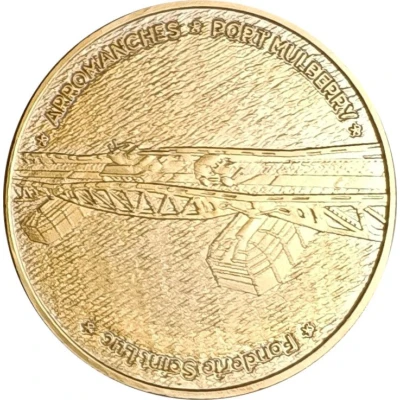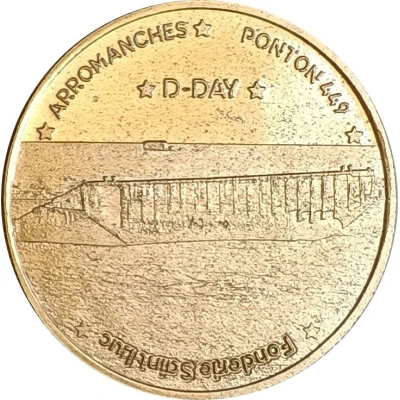Reverse
Representation of a pontoon of the artificial harbour of Arromanches built by the Allies during the Second World War.
Script: Latin
Lettering:
* ARROMANCHES * PONTON *
*Fonderie Saint Luc *
Edge
Reeded
Comment
Mulberry Harbour was a prefabricated harbour built on the Normandy coast during the Second World War to allow the supply of the Allies in the days following the Normandy landings. In fact, two harbours were built off the beaches of Calvados, but only the one at Arromanches was operational, the second one in front of Omaha Beach having been destroyed by a storm on June 19th 1944. The construction of this port avoided the need for the Allies to take a deep water port directly. Mulberry Harbour was made up of various large elements that were prefabricated in England, transported and assembled on the Normandy coast. This artificial harbour has often been highlighted as having enabled the success of the Battle of Normandy and presented as a breakthrough in military logistics.
This is an automatic translation. The original text is:
Le port Mulberry (en anglais: Mulberry Harbour) est un port préfabriqué construit sur la côte normande pendant la Seconde Guerre mondiale pour permettre l'approvisionnement des Alliés dans les jours qui suivirent le débarquement de Normandie. En fait, deux ports furent assemblés au large des plages du Calvados, mais seul celui d'Arromanches fut opérationnel, le second devant Omaha Beach ayant été détruit par une tempête le 19 juin 1944. La construction de ce port évitait aux Alliés de devoir prendre directement un port en eau profonde. Le port Mulberry était constitué de différents grands éléments préfabriqués en Angleterre, acheminés et assemblés sur la côte normande. Ce port artificiel a souvent été mis en avant comme ayant permis la réussite de la bataille de Normandie et présenté comme une trouvaille en matière de logistique militaire.






